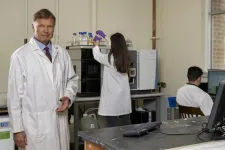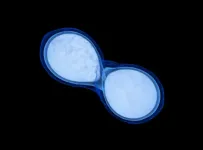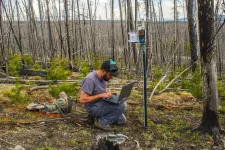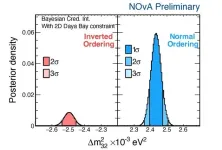(Press-News.org) Using sound to stimulate certain brain waves has the potential to help those with dementia or cognitive decline sleep better, reveals a new study. Sleep disturbances are a common feature in dementia and may affect up to half of people living with the condition.
During the study, the research team from the University of Surrey and the UK Dementia Research Institute Centre for Care Research & Technology at Imperial College London, used sound stimulation to target alpha rhythms, a type of brainwave, at precise timings of the wave to investigate how the brain responds.
Alpha rhythms have been associated with memory and perception, and changes to the rhythms have been observed in those experiencing cognitive decline and dementia.
Senior author Dr Ines Violante, Senior Lecturer in Psychological Neuroscience at the University of Surrey, said:
"Alpha oscillations are a defining characteristic of our brain's electrical activity, but we still do not fully understand their role in shaping fundamental brain functions.
"Using sound is a powerful, non-invasive approach to stimulate certain oscillations within the brain. It is important that we find ways of manipulating these oscillations to create tools for treatment applications, as we know that brain oscillations are slower in diseases, such as Alzheimer's disease."
In a series of experiments, researchers used an innovative brain modulation technique known as Alpha Closed-Loop Auditory Stimulation (aCLAS), in which sounds are timed to the precise phase of alpha rhythms. To monitor the effect of stimulation, measurements of electrical activity from the brain were continuously read in real-time, and when a brain wave reached a particular phase, a sound (a burst of pink noise) was played on the participant.
Researchers observed that depending on the phase at which the sound was played, the alpha rhythm became faster or slower. The effect was also dependent on where the alpha oscillations were coming from in the brain.
Dr Henry Hebron, a former doctoral student at the University of Surrey and first author of the publication, said:
"What we have found is that alpha oscillations can be manipulated via sound when we address this rhythm on its own terms, using a closed-loop approach. Surprisingly, when we performed our aCLAS experiment as participants were falling asleep, we observed that sounds at a particular phase prevented them from reaching deeper stages of sleep (without waking them), while the same sounds at a different phase were not disruptive.
"There is a lot more to be explored regarding neural oscillations-dependent behaviours, and we believe closed-loop approaches, such as the one we implemented here, could be key."
According to researchers, now they have shown they are able to influence Alpha waves with sound, the next steps will be to explore if they can modify the waves in such a way that enhances cognition and sleep, which could ultimately benefit dementia patients.
Professor Derk-Jan Dijk, Director of the Surrey Sleep Research Centre and Group Leader at the UK Dementia Research Institute Centre for Care Research & Technology Centre, said:
"There is much to be uncovered about the role of the alpha rhythm in sleep and cognition. This technique could be influential in pushing our understanding and improving sleep functions in those with dementia. We are now investigating the effects of this closed-loop auditory stimulation approach in REM sleep, where alpha rhythms are present but their role still unknown."
The research contributes to the United Nations' Sustainable Development Goal 3 – Good Health and Well-being.
This study was published in the journal PLOS Biology (Link will go live when paper is published).
Notes to editors
Dr Ines Violante, Dr Henry Hebron and Professor Derk-Jan Dijk are available for interview on request.
For more information, please email mediarelations@surrey.ac.uk
END
Sound stimulation with precise timings can help understand brain wave functions
2024-06-18
ELSE PRESS RELEASES FROM THIS DATE:
Rutgers Health researchers find disparities in outcomes of hospice discharges
2024-06-18
Black patients who leave hospice care and patients with short stays in hospice care are at increased risks for being admitted to a hospital after being discharged from hospice, according to Rutgers Health researchers.
Their study, published in JAMA Network Open, examined patient outcomes after hospice care discharges to determine what factors contribute to transitions that lead to negative health implications.
“Hospice care teams may want to pay particular attention to the discharge planning needs of patients of racial and ethnic minority groups and patients with more complicated needs,” said Elizabeth Luth, the lead author of the study and ...
Mirror-image chemicals may revolutionize drug delivery
2024-06-18
Cyclodextrins (CDs) are complicated carbohydrates, a term that describes the natural, sugar-based, starchy material that makes up much of fruits, vegetables and grains.
Their unique chemical properties make them ideal for all sorts of uses, including air fresheners, medications and cosmetics. Scientists also are exploring their potential to treat cardiovascular diseases caused by atherosclerotic plaques.
Now, more than 130 years after CDs were first discovered and reported, a University of Texas at Arlington team of scientists has created chemical mirror images of these complex ...
What happens when neutron stars collide?
2024-06-18
UNIVERSITY PARK, Pa. — When stars collapse, they can leave behind incredibly dense but relatively small and cold remnants called neutron stars. If two stars collapse in close proximity, the leftover binary neutron stars spiral in and eventually collide, and the interface where the two stars begin merging becomes incredibly hot. New simulations of these events show hot neutrinos — tiny, essentially massless particles that rarely interact with other matter — that are created during the collision can be briefly trapped at these interfaces and remain out of equilibrium with the cold cores of the merging stars for 2 to 3 milliseconds. ...
Researchers leverage shadows to model 3D scenes, including objects blocked from view
2024-06-18
Imagine driving through a tunnel in an autonomous vehicle, but unbeknownst to you, a crash has stopped traffic up ahead. Normally, you’d need to rely on the car in front of you to know you should start braking. But what if your vehicle could see around the car ahead and apply the brakes even sooner?
Researchers from MIT and Meta have developed a computer vision technique that could someday enable an autonomous vehicle to do just that.
They have introduced a method that creates physically accurate, 3D models of an entire scene, including areas blocked from view, ...
Is coffee good for you or bad for you?
2024-06-18
Coffee drinking is a heritable habit, and one that carries a certain amount of genetic baggage.
Caffeinated coffee is a psychoactive substance, notes Sandra Sanchez-Roige, Ph.D., an associate professor in the University of California San Diego School of Medicine Department of Psychiatry. She is one of an international group of researchers that compared coffee-consumption characteristics from a 23andMe database with an even larger set of records in the United Kingdom. She is the corresponding author of a study recently published in the journal Neuropsychopharmacology.
Hayley ...
CWRU researcher, interdisciplinary team discover breakthrough on body’s adaptation to COVID-19
2024-06-18
CLEVELAND—Since 2020, the COVID-19 pandemic has presented significant challenges to global public health, infecting millions and claiming numerous lives. While widespread vaccination efforts have alleviated the immediate threat, lingering questions persist about the long-term effects of the virus on those infected.
An interdisciplinary team of scientists has made a significant breakthrough to understand how the body adapts to COVID-19 infection, potentially offering crucial insights into managing the complex disease. Led by Christopher Wilson, professor of medicine at Loma Linda University, the collaborative effort involved ...
New guidelines for radiation therapy for HPV-associated head and neck cancer
2024-06-18
Study Title: Radiation Therapy for HPV-Positive Oropharyngeal Squamous Cell Carcinoma: An ASTRO Clinical Practice Guideline
Publication: Practical Radiation Oncology
Dana-Farber Cancer Institute author: Danielle Margalit, MD, MPH
Summary: A multi-disciplinary task force convened by the American Society for Radiation Oncology has issued new guidelines for radiation therapy for HPV-associated oropharyngeal squamous cell carcinoma (OPSCC). The expert task force recommends optimal dosing regimens for radiation therapy when used alone or after surgery, incorporating the latest data on minimizing doses to areas that may affect patient quality of life such as swallowing. ...
Argonne’s South Side STEM Opportunity Landscape Project dedicated to STEM equity wins Societal Impact Award
2024-06-18
The Argonne in Chicago South Side STEM Opportunity Landscape Project was awarded the Societal Impact Award by the Chicago Council on Science and Technology (C2ST) for its commitment to advancing equity and opportunity in STEM education and careers across underserved communities.
C2ST is a nonprofit that works to inspire and engage all segments of society about science and technology and their contributions to society. The South Side STEM Opportunity Landscape Project is part of Argonne in Chicago, which is focused on driving inclusive innovation to advance economic and societal impacts for underserved and underrepresented communities. The ...
Wildfire resilience initiative launches with $3.7 million in seed funding from the Gordon and Betty Moore Foundation
2024-06-18
The Gordon and Betty Moore Foundation has awarded $3.7 million to kickstart the Western Fire & Forest Resilience Collaborative, led by Winslow Hansen, a forest ecologist at Cary Institute of Ecosystem Studies. Funds are enabling the formation of an interdisciplinary collaborative that will advance science-based management solutions to the growing wildfire crisis.
In the Western US, climate change and a legacy of fire suppression have led to larger, more severe, and more frequent fires — with devastating consequences for people, natural resources, and the climate. By dramatically speeding ...
New NOvA results add to mystery of neutrinos
2024-06-18
The international NOvA collaboration presented new results at the Neutrino 2024 conference in Milan, Italy, on June 17. The collaboration doubled their neutrino data since their previous release four years ago, including adding a new low-energy sample of electron neutrinos. The new results are consistent with previous NOvA results, but with improved precision. The data favor the “normal” ordering of neutrino masses more strongly than before, but ambiguity remains around the neutrino’s oscillation properties.
The latest NOvA data provide a very precise measurement ...






